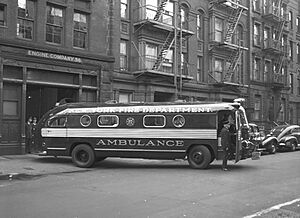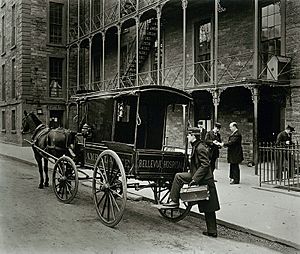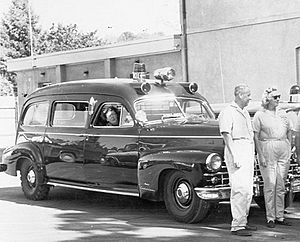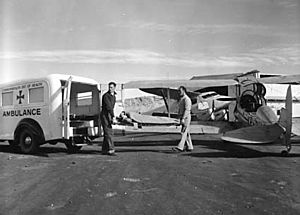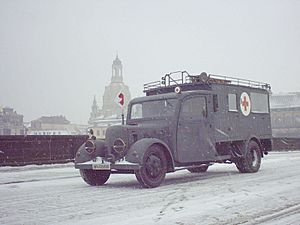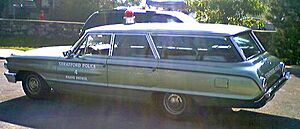History of the ambulance facts for kids
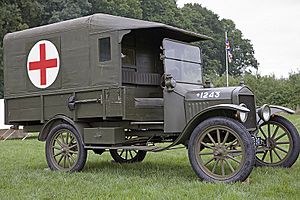
Ambulances have a long and interesting history, starting way back in ancient times when people used simple carts to move sick or injured patients. The very first time ambulances were used for emergencies was in 1487 by the Spanish army during a battle called the siege of Málaga. Later, in the 1830s, regular ambulances for everyday people started to appear. Over time, with amazing new inventions in the 1800s and 1900s, ambulances became the self-powered vehicles we know today.
Contents
- Moving Patients in Early Times
- Battlefield Care Evolves
- Ambulances for Everyone Else
- American Civil War Innovations
- Hospitals Start Ambulance Services
- Special Ambulance Groups Begin
- Public Transport as Ambulances
- Motorized Ambulances Arrive
- World War I Changes Everything
- Air Ambulances Take Flight
- World War II's Impact
- Helicopters and On-Scene Care
- Modern Ambulances Today
- See also
Moving Patients in Early Times
Even in ancient times, there's proof that people were moved by force if they had serious mental health issues or diseases like leprosy. One of the earliest records of an ambulance-like vehicle was a cart with a hammock, made by the Anglo-Saxons around 900 AD.
During the Crusades in the 11th century, a group called the Knights Hospitaller set up hospitals to help pilgrims injured in battles. We don't know exactly how the wounded got to these hospitals, but they were important for care.
The Normans used a special stretcher that hung between two horses. Different versions of these horse stretchers and horse-drawn wagons were used for a very long time, right up until the 1900s!
Battlefield Care Evolves
The first time ambulances were used in an emergency was with Isabella I of Castile's troops in 1487. The Spanish army had good medical care, and they even had the first military hospitals, called ambulancias. But there was a problem: injured soldiers were only picked up after the fighting stopped, meaning many died on the battlefield.
A big change happened thanks to Dominique Jean Larrey (1766–1842), who became Napoleon Bonaparte’s main doctor. Larrey saw a battle where wounded soldiers weren't picked up until the fighting was over. He decided to create a new system. Instead of the old horse stretchers, he designed two- or four-wheeled wagons pulled by horses. These wagons would pick up injured soldiers from the active battlefield after they got some quick first aid.
Larrey called his new ambulances "flying ambulances" (ambulances volantes) because they were so quick and easy to move, like the "flying artillery" used by the French army. These flying ambulances were first used in 1793. Larrey even made special ambulances for Napoleon's armies, including a stretcher that could be carried by a camel for a campaign in Egypt!
Ambulances for Everyone Else
A big step forward for ambulances used by regular people happened in London in 1832. A special carriage was made to transport patients with cholera. The Times newspaper wrote that this new carriage meant patients could start getting better as soon as they were put inside. It saved time and allowed hospitals to be further apart.
American Civil War Innovations
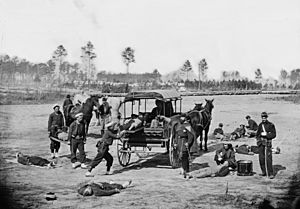
More improvements in military medical care came during the American Civil War in the United States. Union army doctors Joseph Barnes and Jonathan Letterman built on Larrey’s ideas. They created a system to care for soldiers before they reached a hospital. Every army group had at least one ambulance cart. At first, they used lightweight two-wheeled carts, but these were replaced by stronger four-wheeled "Rucker" ambulances.
Other vehicles were also used, like steamboats, which became floating hospitals. It was also during this war that injured soldiers started to be transported to hospitals by railroad.
Hospitals Start Ambulance Services
The first hospital-based ambulance service started in 1865 at Commercial Hospital in Cincinnati, Ohio. Soon after, Bellevue Hospital in New York City started its own service in 1869. Edward Dalton, a former army surgeon, believed that getting patients to the hospital quickly and comfortably was key.
These early ambulances carried medical supplies like splints, a stomach pump, and medicines. Dalton wanted speed, so horses were kept ready to go in just 30 seconds! The service became very popular, with calls tripling in just 21 years. At first, hospital staff worked on the ambulances, but soon, young doctors in training were assigned to them.
In 1867, London in the United Kingdom got six horse-drawn ambulances to move patients with diseases like smallpox. These ambulances looked like regular carriages but had special features to easily load a patient on a bed. They were also designed to be easy to clean and disinfect.
Special Ambulance Groups Begin
In 1880, a doctor named Reginald Harrison suggested a horse-drawn ambulance for Liverpool, England. This led to Britain's first ambulance service, started in 1884 at the Liverpool Northern Hospital.
In June 1887, the St John Ambulance Brigade was created in London. Its goal was to provide first aid and ambulance services at public events. This group taught first aid for 10 years before starting the ambulance service. Today, St John Ambulance helps people in many countries around the world.
In Ireland, the St John Ambulance started in 1903 for workers at the Guinness Brewery in Dublin. It later became an important ambulance service during the 1916 rising and World War II. In 1938, the Order of Malta Ambulance Corps was set up in Galway, Ireland. It's now Ireland's largest volunteer ambulance service.
In Queensland, Australia, a military medic named Seymour Warrian started an ambulance service in 1892. He saw a rider with a broken leg being walked off a field, which made his injury worse. So, the Queensland Ambulance Transport Brigade was formed. Their first station was in a newspaper company, and officers slept on newspaper rolls! They started by carrying patients on foot, then got horse-drawn stretchers, and finally vehicles. This group grew huge, and in 1991, it became the Queensland Ambulance Service, one of the biggest ambulance services in the world.
Public Transport as Ambulances
In the late 1800s, St Louis, Missouri, United States began using a special tram car as an ambulance on its streetcar network. This tram ambulance, introduced in 1894, could reach all 16 hospitals in the city. In 1913, trolley cars in Bahia, Brazil, even had a special area for cleaning and a two-bed section for nurses.
In Germany, in 1902, a civilian ambulance train was introduced for railway accidents. It had a mobile operating room and eight stretchers. Doctors who worked for the railroad lived near the station where the train was kept, ready to be called for emergencies. This train had special priority on the tracks, meaning all other trains had to move out of its way!
Motorized Ambulances Arrive
As cars were invented in the late 1800s, they slowly started to replace horse-drawn ambulances. Early 1900s ambulances used steam, gasoline, or electricity to move. The very first motor-powered ambulance was used in February 1899 by the Michael Reese Hospital in Chicago. New York City followed in 1900, praising the new vehicles for being faster, safer, and smoother. These first two car ambulances ran on electricity.
The first ambulance powered by gasoline was the Palliser Ambulance, introduced in 1905. It was a three-wheeled vehicle designed for battlefields and covered in bulletproof steel! The steel shields could even open up to give cover to the ambulance staff.
On October 6, 1909, Vancouver’s first car ambulance went for a test drive. Sadly, it was involved in an accident where a pedestrian died. The ambulance's first job was to take the man to the hospital, but he had already passed away.
The British Army quickly started using some car ambulances too. In 1905, they used Straker-Squire motor ambulance vans, which were based on a double-decker bus!
The first mass-produced car ambulance was made in the United States in 1909 by the James Cunningham, Son & Company. This ambulance, called the Model 774, had a 4-cylinder engine, rubber tires, electric lights, and a special cot for patients.
World War I Changes Everything
During World War I, the Red Cross brought in the first widespread use of motor ambulances on battlefields. They were so successful that horse-drawn ambulances quickly disappeared. For regular emergencies, hospitals often managed their own ambulance services. But with new inventions like the telegraph and telephone, police departments sometimes helped by sending ambulances where they were needed.
The equipment inside ambulances also changed quickly. Special splints for leg fractures were introduced during World War I, which greatly helped injured patients. After the war, two-way radios became available, making it much easier to send ambulances to emergencies. By the time World War II was about to start, a modern ambulance had advanced medical equipment, a doctor on board, and was sent out by radio. Many ambulances were actually hearses (vehicles used for funerals) because they were the only ones that could carry a patient lying down. These were called "combination cars."
Air Ambulances Take Flight
After World War I, planes became more common. People started finding new uses for them, including turning them into ambulance planes. In 1917, a medical student named Lieutenant Clifford Peel imagined a system of planes and ground facilities to provide medical help in the Australian Outback. The first planes built specifically as air ambulances appeared in the late 1920s.
These ideas became real in 1928 thanks to John Flynn. His group, the Australian Inland Mission, started the Aerial Medical Service. Doctors in this program would fly to a patient, treat them, and if needed, fly them to a hospital. This experiment eventually became the famous Royal Flying Doctor Service of Australia.
World War II's Impact
During World War II, the quality of ambulance services dropped in many parts of the world. Doctors were needed by the armed forces and were taken off ambulances. In the United Kingdom, during the Battle of Britain, there was such a huge need for ambulances that regular vans were quickly turned into ambulances, often carrying many injured people at once.
After the war, doctors continued to ride ambulances in some countries but not others. Other vehicles, like civilian cars and police cars, were also used to transport patients because there weren't enough dedicated ambulances. Military ambulances like the Austin K2/Y and the American Dodge WC-54 were used on battlefields and at home.
Helicopters and On-Scene Care
During the Korean War, the new United States Air Force used helicopters to quickly move injured soldiers from the battlefield to medical units. The H-13 Sioux helicopter, famous from the TV show M*A*S*H, moved 18,000 wounded soldiers during that war! This success led to helicopters being used for emergency medical help in civilian life too.
After a big train crash in Britain in 1952, ambulances were changed to be more like "mobile hospitals" instead of just transport. This led to the modern ambulances we see today. New life-saving techniques like CPR (Cardiopulmonary Resuscitation) and defibrillation (using electric shocks to the heart) were developed. New medicines for heart problems also appeared. Studies showed that ambulance services needed to be improved.
This led to new standards for how ambulances were built. For example, the inside of the patient area had to be tall enough for a medical worker to stand and care for the patient during transport. The equipment ambulances carried also became standardized.
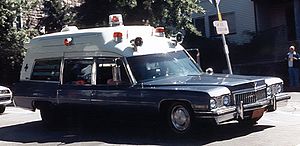
Many older ambulances couldn't meet these new standards. So, ambulance design changed a lot in the 1970s. Car-based ambulances with high roofs were tried, but car frames weren't strong enough. So, vans and later light trucks were used instead. Early van ambulances looked a lot like regular vans, but they had emergency lights and sirens, and special insides for medical equipment and a stretcher.
The Freedom House Ambulance Service in 1967 was the first in the United States to have paramedics with advanced medical training. As time went on, ambulances grew with the new EMS (Emergency Medical Services) system. They gained the ability to carry more equipment, and their design improved to make it easier for EMTs and paramedics to work inside.
Modern Ambulances Today
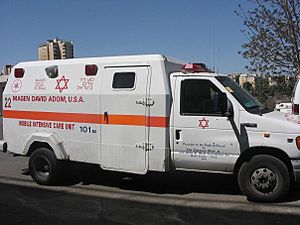
Today, many ambulances are custom-built. They have special medical equipment built right in. Vehicle design has also improved generally, with better lights and sirens to keep crews safe, especially at accident scenes. Features like ABS (Anti-lock Braking System) are also very helpful for ambulances because of the speeds they reach and the heavy weight they carry.
There have also been improvements to help keep ambulance crews healthy and safe. For example, some ambulances have special lifts, ramps, and winches to help load patients, so crews don't have to do as much heavy lifting.
Ambulance design is still changing! This is because paramedics and other ambulance crew members are learning new skills and using more specialized equipment. Also, there's a constant need to protect ambulance crews from common accidents like traffic crashes, and from rarer, but serious, events like terrorist activities.
See also
- Dodge WC54
- Combat medic


